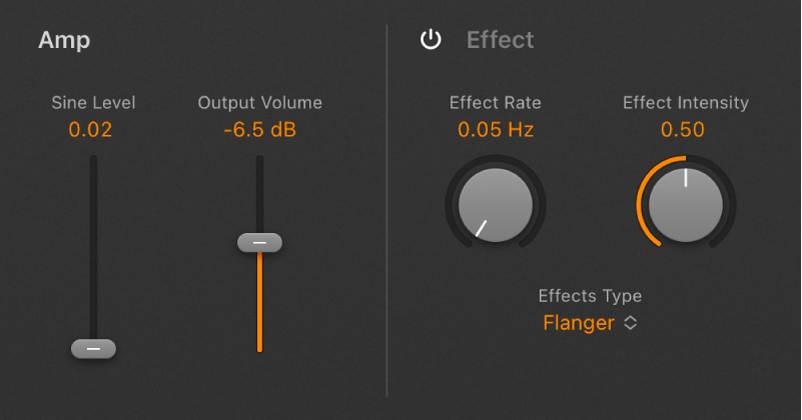Logic Pro User Guide for iPad
- What’s new in Logic Pro 1.1
-
- What is Logic Pro?
- Working areas
- Work with function buttons
- Work with numeric values
-
- Intro to tracks
- Create tracks
- Create tracks using drag and drop
- Choose the default region type for a software instrument track
- Select tracks
- Duplicate tracks
- Reorder tracks
- Rename tracks
- Change track icons
- Change track colors
- Use the tuner on an audio track
- Show the output track in the Tracks area
- Delete tracks
- Edit track parameters
- Start a Logic Pro subscription
- How to get help
-
- Intro to recording
-
- Before recording software instruments
- Record software instruments
- Record additional software instrument takes
- Record to multiple software instrument tracks
- Record multiple MIDI devices to multiple tracks
- Record software instruments and audio simultaneously
- Merge software instrument recordings
- Spot erase software instrument recordings
- Replace software instrument recordings
- Capture your most recent MIDI performance
- Use the metronome
- Use the count-in
-
- Intro to arranging
-
- Intro to regions
- Select regions
- Cut, copy, and paste regions
- Move regions
- Remove gaps between regions
- Delay region playback
- Trim regions
- Loop regions
- Repeat regions
- Mute regions
- Split and join regions
- Stretch regions
- Separate a MIDI region by note pitch
- Bounce regions in place
- Change the gain of audio regions
- Create regions in the Tracks area
- Convert a MIDI region to a Drummer region or a pattern region
- Rename regions
- Change the color of regions
- Delete regions
- Create fades on audio regions
- Access mixing functions using the Fader
-
- Intro to Step Sequencer
- Use Step Sequencer with Drum Machine Designer
- Record Step Sequencer patterns live
- Step record Step Sequencer patterns
- Load and save patterns
- Modify pattern playback
- Edit steps
- Edit rows
- Edit Step Sequencer pattern, row, and step settings in the inspector
- Customize Step Sequencer
-
- Effect plug-ins overview
-
- Instrument plug-ins overview
-
- ES2 overview
- Interface overview
-
- Modulation overview
-
- Vector Envelope overview
- Use Vector Envelope points
- Use Vector Envelope solo and sustain points
- Set Vector Envelope segment times
- Vector Envelope XY pad controls
- Vector Envelope Actions menu
- Vector Envelope loop controls
- Vector Envelope release phase behavior
- Vector Envelope point transition shapes
- Use Vector Envelope time scaling
- Use the Mod Pad
- Modulation source reference
- Via modulation source reference
-
- Sample Alchemy overview
- Interface overview
- Add source material
- Save a preset
- Edit mode
- Play modes
- Source overview
- Synthesis modes
- Granular controls
- Additive effects
- Additive effect controls
- Spectral effect
- Spectral effect controls
- Filter module
- Low and highpass filter
- Comb PM filter
- Downsampler filter
- FM filter
- Envelope generators
- Mod Matrix
- Modulation routing
- Motion mode
- Trim mode
- More menu
- Sampler
- Copyright
Retro Synth amp and effect controls in Logic Pro for iPad
Retro Synth amp controls set the overall volume. You can also mix a sine wave directly into the output stage, which thickens the sound. You can make the sound richer with the integrated Chorus effect or can add a sweeping, metallic character with the Flanger effect. If you’re new to synthesizers and the concepts behind amp controls, see Intro to synthesizers.

Amp parameters
Output Volume slider and field: Set the overall output level.
Sine Level slider and field: Mix a sine wave at the frequency of oscillator 1 (Shape 1) directly into the output stage. This sine signal is not processed by the filter.
Effect parameters
On/off button: Turn the effect section on or off.
Effect Rate knob and field: Set the modulation speed of the effect.
Effect Intensity knob and field: Set the level of the effect and balance between the original and effect signals.
Effects Type pop-up menu: Choose either the Chorus or Flanger effect.
The Chorus effect is based on a delay line, the output of which is mixed with the original, dry signal. The short delay time is modulated periodically, resulting in pitch deviations. The modulated deviations, in conjunction with the original signal pitch, produce the chorus effect.
The Flanger effect works in a similar fashion to the chorus, but with even shorter delay times. The output signal is fed back into the input of the delay line. This feedback results in the creation of harmonic resonances that cyclically move through the frequency spectrum, resulting in a sweeping, metallic sound.
Tip: Use Logic Pro effects if you need more precise control of chorus and flanging or want to use both effects simultaneously.
Download this guide: PDF